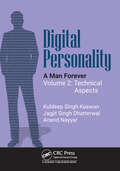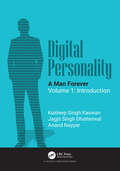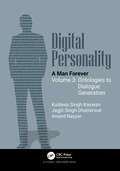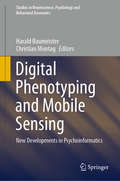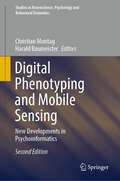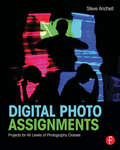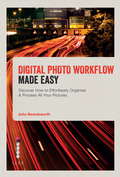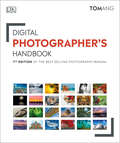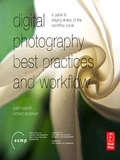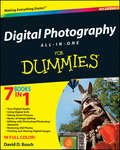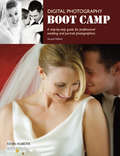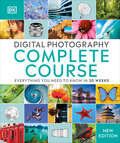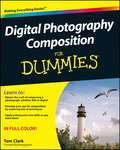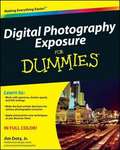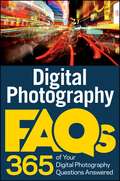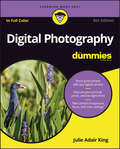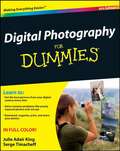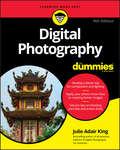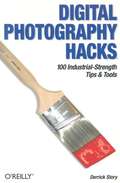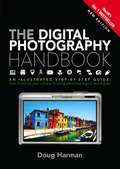- Table View
- List View
Digital Personality: A Man Forever Volume 2: Technical Aspects
by Anand Nayyar Jagjit Singh Dhatterwal Kuldeep Singh KaswanA computer that imbibes human characteristics is considered to have a digital personality. The character is akin to real-life human with his/her distinguishing characteristics such as history, morality, beliefs, abilities, looks, and sociocultural embeddings. It also contains stable personality characteristics; fluctuating emotional, cognitive, SOAR technology, and motivational states. Digital Personality focuses on the creation of systems and interfaces that can observe, sense, predict, adapt to, affect, comprehend, or simulate the following: character based on behavior and situation, behavior based on character and situation, or situation based on character and behavior. Character sensing and profiling, character-aware adaptive systems, and artificial characters are the three primary subfields in digital personality.Digital Personality has attracted the interest of academics from a wide range of disciplines, including psychology, human-computer interaction, and character modeling. It is expected to expand quickly as technology and computer systems become more and more intertwined into our daily lives. Digital Personality is expected to draw at least as much attention as Affective Computing. The goal of affective computing is to enable computers to comprehend both spoken and nonverbal messages from people, use implicit body language, gaze, speech tones, and facial expressions, etc. to infer the emotional state and then reply appropriately or even show affect through interaction modalities. More natural and seamless human-computer connection would be the larger objective. Users will benefit from a more individualized experience as a result. Additionally, this will affect how well the user performs since they will have the assistance of the robots to do their jobs quickly and effectively.This book provides an overview of the character dimensions and how technology is aiding this area of study. It offers a fresh portrayal of character from several angles. It also discusses the applications of this new field of study.
Digital Personality: Volume 1: Introduction
by Anand Nayyar Jagjit Singh Dhatterwal Kuldeep Singh KaswanThis book delves into the very core of our digital existence, unearthing the essence of a digital persona. It's a realm where authenticity meets multiplicity, as we decipher the nuanced art of crafting and managing our online identities. We confront issues of privacy and ethics, exploring the profound impact of our digital footprints on our lives and society. The integration of AI paves the way for an intriguing future, with predictions that challenge our understanding of self in the digital age. Welcome to a world where your digital personality is more than just data; it's a reflection of who you are and who you can be. The main goal of this book is to enable more seamless and natural human–computer interaction. This will provide better personalized experience. Further, this will influence the performance of the user, wherein they will have the support of the machines to achieve their tasks in the most efficient way. This book is the first of a kind in introducing Digital Personality. It provides an overview of the character dimensions and how state-of-the-art technologies would accommodate such a research field. It includes novel representation of character from various perspectives. It also provides instances of applications of this emerging research field.
Digital Personality: Volume 3: Ontologies to Dialogue Generation
by Anand Nayyar Jagjit Singh Dhatterwal Kuldeep Singh KaswanThe book explores the creation of digital personalities that mimic human behaviour and cognition, authored by AI and computer science experts. It covers the technical foundations needed to develop advanced digital personas, focusing on the integration of ontologies, natural language processing (NLP), and dialogue generation. Ontologies are highlighted for their role in structuring knowledge, while NLP techniques are explored for enabling human-like dialogue. The book examines algorithms for sentiment analysis, entity recognition, and context understanding. Dialogue generation is also discussed, from rule-based methods to deep learning, emphasizing seamless user interactions. Ethical concerns, such as privacy, bias, and accountability, are addressed, advocating for responsible AI practices. This volume is a comprehensive resource for researchers and enthusiasts, offering both theoretical insights and practical guidance on building lifelike digital entities and fostering emotionally engaging human-computer interactions.
Digital Phenotyping and Mobile Sensing: New Developments in Psychoinformatics (Studies in Neuroscience, Psychology and Behavioral Economics)
by Christian Montag Harald BaumeisterThis book offers a snapshot of cutting-edge applications of mobile sensing for digital phenotyping in the field of Psychoinformatics. The respective chapters, written by authoritative researchers, cover various aspects related to the use of these technologies in health, education, and cognitive science research. They share insights both into established applications of mobile sensing (such as predicting personality or mental and behavioral health on the basis of smartphone usage patterns) and emerging trends. Machine learning and deep learning approaches are discussed, and important considerations regarding privacy risks and ethical issues are assessed. In addition to essential background information on various technologies and theoretical methods, the book also presents relevant case studies and good scientific practices, thus addressing researchers and professionals alike. To cite Thomas R. Insel, who wrote the foreword to this book: “Patients will only use digital phenotyping if it solves a problem, perhaps a digital smoke alarm that can prevent a crisis. Providers will only use digital phenotyping if it fits seamlessly into their crowded workflow. If we can earn public trust, there is every reason to be excited about this new field. Suddenly, studying human behavior at scale, over months and years, is feasible.”
Digital Phenotyping and Mobile Sensing: New Developments in Psychoinformatics (Studies in Neuroscience, Psychology and Behavioral Economics)
by Christian Montag Harald BaumeisterThis book offers a snapshot of cutting-edge applications of digital phenotyping and mobile sensing for studying human behavior and planning innovative e-healthcare interventions. The respective chapters, written by authoritative researchers, cover both theoretical perspectives and good scientific and professional practices related to the use and development of these technologies. They share novel insights into established applications of mobile sensing, such as predicting personality or mental and behavioral health on the basis of smartphone usage patterns, and highlight emerging trends, such as the use of machine learning, big data and deep learning approaches, and the combination of mobile sensing with AI and expert systems. Important issues relating to privacy and ethics are analyzed, together with selected case studies. This thoroughly revised and extended second edition provides researchers and professionals with extensive information on the latest developments in the field of digital phenotyping and mobile sensing. It gives a special emphasis to trends in diagnostics systems and AI applications, suggesting important future directions for research in public health and social sciences.
Digital Photo Assignments: Projects for All Levels of Photography Classes (Photography Educators Series)
by Steve AnchellThis collection of more than 40 photo assignments is designed to help all students—from beginning freshmen to experienced seniors—improve or reinvigorate their work and reach their full potential as photographers. Whether you are building a syllabus for your first photography class, revitalizing assignments for your students, or looking to add DSLR video, workflow, or color correction to your class, you will find a wealth of ideas in this wonderful working guide. The assignments begin with using the camera, and progress through learning composition and lighting, working in genres, building a portfolio and more.
Digital Photo Workflow Made Easy: Discover How to Effortlessly Organise & Process All Your Pictures
by John BeardsworthDo you know where all your photos are? Can you retrieve every landscape shot or portrait you've ever taken with a few keystrokes and a click of the mouse? Are you looking forward to processing those hundreds or thousands of holiday snapshots? There's no reason why you shouldn't, and this book holds all the answers, and quite a few expert secrets as well.Learn to take advantage of the processes and features of your software of choice to streamline your photo workflow. With advanced methods, tried and tested by an expert photographer, you'll be set on a straightforward path to great, reliable results in no time at all.
Digital Photographer's Handbook: 7th Edition of the Best-Selling Photography Manual (DK Tom Ang Photography Guides)
by Tom AngDiscover how to get the very best from your photography with clear step-by-step guidance from expert photographer, Tom Ang. In this fully comprehensive photography companion, renowned photographer and teacher Tom Ang teaches you how to capture, enhance, and transform your photographs.The first half of the book explains all of the essential techniques that every photographer needs to learn - from how to handle your camera correctly and understand its features, to composing a successful shot.The second half develops your understanding of photography, guiding you through a range of projects that focus on different photographic genres and subjects, including landscapes, cityscapes, and live events. It explains how to digitally enhance your images, not only to improve the original shot, but also to apply creative techniques that will take your image to a new level. This section also gives advice on the best way to share your work, to choosing the most suitable equipment, and should you wish, how to develop a career in photography.
Digital Photographic Workflow Handbook: A Guide to Staying Ahead of the Workflow Curve
by Patricia RussottiThe current existing workflow content out there deals only in RAW or DAM (Digital Asset Management) and can be extremely difficult and daunting to read. The Digital Photographic Workflow Handbook is a coherent, concise guide to all of the aspects of workflow that digital photographers and digital imagers need from shooting to archiving and everything in between -- written in a way that an artist/photographer can understand. It also has resources and links to stay current and up to speed with the rapid changes in technology, a Website that you can return to for the latest advances in workflow, and a glossary to use as you develop Standard Operating Procedures to synthesize your workflow and communication processes. This book will give you all of the workflow steps you will need -- from shooting to archiving and everything in between -- and is written in a way that a way that you can understand. This handbook is software version independent and focuses more on the key fundamentals that are a constant from software version to software version.
Digital Photography All-in-One Desk Reference For Dummies
by David D. BuschIt's easy to get started in digital photography and take great photos with Digital Photography All-in-One Desk Reference For Dummies! This fourth edition helps you choose the right camera, compose and capture great photos, load them onto your computer, enhance them with Photoshop, and share them online or as prints. Here's how to compare digital camera features, choose accessories, and explore digital SLRs; get great close-ups, sports and action shots, and portraits; and use image editors including Paint Shop Pro, Corel PhotoPaint, PhotoImpact, and Adobe's popular Photoshop and Photoshop Elements. You'll also discover how to:Compose pictures that communicateMake the most of macro photographyGet great candid photosCreate the right lighting and use cool lighting gadgetsTake advantage of six cool improvements in digital SLRsFollow great ideas for getting your photos publishedTake great shots in a wide range of situationsLearn to repair and restore treasured heirloom photosTurn your images into greeting cards, T-shirts, online albums, or printsYou'll quickly find what you need in one of the seven minibooks:Your Digital StudioUsing Digital SLRsTaking Great PicturesBasics of Image EditingEditing with Photoshop/Photoshop ElementsRestoring Old PhotosPrinting and Sharing Digital ImagesDigital Photography All-in-One Desk Reference For Dummies, 4th Edition gets you up to speed on digital cameras and all the tricks, so you can truly enjoy your digital photography experience.
Digital Photography Boot Camp
by Kevin KubotaDesigned to give professional photographers of all skill levels a complete look at the working digital studio, this reference goes from start to finish-from setting up the camera and capturing the best possible images to organizing, enhancing, and printing the completed photos. Written by an experienced, successful professional photographer and lecturer, this newly revised guide takes a lighthearted approach to complete foundation information, as well as advanced tips and tricks for those ready to push their digital imaging to the next level. Intensive chapters cover Photoshop essentials for retouching or adding artistic effects, managing workflow and clients, and the many finishing options in the digital medium, including slide shows, DVDs, and magazine-style albums and collages. With a clear and upbeat approach, this reference provides quality technical information, while inspiring photographers to look closely at their work to see where a little finesse could elevate their businesses.
Digital Photography Boot Camp
by Kevin KubotaDesigned to give professional photographers of all skill levels a complete look at the working digital studio, this reference goes from start to finish--from setting up the camera and capturing the best possible images to organizing, enhancing, and printing the completed photos. Written by an experienced, successful professional photographer and lecturer, this newly revised guide takes a lighthearted approach to complete foundation information, as well as advanced tips and tricks for those ready to push their digital imaging to the next level. Intensive chapters cover Photoshop essentials for retouching or adding artistic effects, managing workflow and clients, and the many finishing options in the digital medium, including slide shows, DVDs, and magazine-style albums and collages. With a clear and upbeat approach, this reference provides quality technical information, while inspiring photographers to look closely at their work to see where a little finesse could elevate their businesses.
Digital Photography Boot Camp
by Kevin KubotaDesigned to give professional photographers of all skill levels a complete look at the working digital studio, this reference goes from start to finish--from setting up the camera and capturing the best possible images to organizing, enhancing, and printing the completed photos. Written by an experienced, successful professional photographer and lecturer, this newly revised guide takes a lighthearted approach to complete foundation information, as well as advanced tips and tricks for those ready to push their digital imaging to the next level. Intensive chapters cover Photoshop essentials for retouching or adding artistic effects, managing workflow and clients, and the many finishing options in the digital medium, including slide shows, DVDs, and magazine-style albums and collages. With a clear and upbeat approach, this reference provides quality technical information, while inspiring photographers to look closely at their work to see where a little finesse could elevate their businesses.
Digital Photography Complete Course: Learn Everything You Need to Know in 20 Weeks (DK Complete Courses)
by DKGrab your camera and learn everything you need to know to improve your photography in just 20 weeks.Introducing Digital Photography Compete Course - the perfect beginner&’s learning program for any aspiring photographer, this photography book aims to teach you everything you need to know about photography in just 20 weeks, through easy-to-understand tutorials. It&’s time to start using your camera to its full potential, and this photography book for beginners can help you do just that. Combining tutorials, step-by-step photo shoots, practical assignments, and fun Q&As, this brilliant book on photography can help you untangle photographic jargon such as aperture, exposure, shutter speed, and depth-of-field; teach you top tips and tricks surrounding the range of modes on bridge and system cameras, and help you to master composition for that perfect photo!Become a photography expert in no time, as you explore:- Review, practice and experiment sections to put photography knowledge to the test - Technical concepts are broken down and explained in simple, accessible language - Easy-to-read diagrams and illustrations to highlight key theories- The latest technological and creative developments in digital photography and image manipulationDK&’s Digital Photography Complete Course is a must-have book for photography lovers of all ages, whether you&’re a photography or art student seeking to learn more about the subject, or a photography beginner looking to improve your own digital photography techniques. Doubling up as the perfect photography gift book for beginners, Digital Photography Compete Course will help you use your camera to its full potential so that you don&’t just take good pictures – you take great ones!
Digital Photography Composition For Dummies
by Thomas ClarkTurn ordinary photographs into striking works of artMastering the craft of composing a photograph is all about having a trained eye. Digital Photography Composition For Dummies helps emerging photographers create stunning and compelling photographs by teaching the elements, techniques, and conventions used by skilled and successful photographers. It helps advanced beginner to aspiring professional photographers gain an understanding of the basics of composing a stunning and compelling photograph, as well as the parts, functions, and capabilities of their camera.Determine the point of interest in a photo and how significance is achievedUse the "Rule of Thirds" to create better photographsManipulate the viewpoint and understand the subject's direction of movementMaster depth of field, framing, and diagonalsIncludes suggested exercises to apply as you become more comfortable with composition techniquesComplete with full-color examples and technique comparisons, Digital Photography Composition For Dummies allows you to take the high-quality photos you've always wanted!
Digital Photography Exposure For Dummies
by Jim Doty Jr.Proper exposure techniques and tips in a single practical guideMost of today's cameras do all the work for the user, yet more and more photographers are looking to add some agility and aptitude to their do-it-all cameras. Digital Photography Exposure For Dummies builds upon skills introduced in Photography For Dummies to guide you through creating the perfect shot. Using aperture and shutter speed techniques, as well as knowledge of ISO sensitivity, lens choice, lighting, and color, you will learn a variety of methods and scenarios to produce astonishing and gripping images.Learn how to control the amount of light let into the lens for each photoFeatures full-color examples and comparisons in techniquesBreaks down the settings and adjustments that should be made to achieve different effectsIncludes suggested exercises to apply as you become more comfortable with new techniquesThe step-by-step instructions in Digital Photography Exposure For Dummies allow you to get the picture you want every time!
Digital Photography FAQs
by Jeff WignallStraightforward, clear answers to the most commonly asked digital photography questionsWhat's the difference between optical zoom and digital zoom? Do more megapixels equate to better photo quality? Why is there a delay after I push the shutter release button before I can take another picture? If you?ve ever asked a question concerning digital photography and wished you had a helpful resource to provide you with clear, reliable answers, then look no further.With nearly four decades of photo experience under his belt, author Jeff Wignall responds to 365 of the most common digital photography questions with informative, practical replies. The full-color format helps you see what he's talking about.Boasts a colorful yet simple design that helps you find exactly the information you?re looking for Illustrates each answer with one or more photos Eliminates any ambiguity by providing you with authoritative answers along with clear illustrationsDigital Photography FAQz is a well-organized guide, featuring answers to questions that you haven?t even thought of yet!
Digital Photography For Dummies
by Julie Adair KingA new edition gets you in the picture for learning digital photographyWhether you have a point-and-shoot or digital SLR camera, this new edition of the full-color bestseller is packed with tips, advice, and insight that you won't find in your camera manual. Digital photography guru Julie Adair King presents you with new and extensively updated information on topics that is written for fledgling photographers in a fun and friendly style. You'll explore tips for finding the gear that best suits your needs, using built-in tools, working with focus and exposure, and shooting like a pro.However, if you've already got an archives full of photos, then this guide shows you how to upload, edit, manage, and share your images. Advice for prolonging battery life, an honest look at the pros and cons of digital SLR, and a helpful glossary are all aimed at making your experience with digital photography picture perfect!Shows you how to set up your camera for basic shooting and use automatic mode, common scene modes, and all the camera's featuresExplains how to edit your images and fix common problems like dim lighting or red-eyeHighlights ways to print photos at home or through a service and then posting online to social sites or send to a cell phoneHelps you manage depth of field, exposure, and white balanceDigital Photography For Dummies, 7th Edition provides you with rich, full-color examples throughout to help your digital pictures say more than a thousand words!
Digital Photography For Dummies, 6th Edition
by Julie Adair King Serge TimacheffYour digital camera can do so much! And Digital Photography For Dummies, 6th Edition helps you shoot, edit, and share great photos. This full-color guide is packed with stuff that's not in your camera manual - tips on upgrading your equipment, working with focus and exposure, shooting like a pro, organizing and enhancing your images, and printing them or getting them online. Are you already you're hip-deep in images? Here's how to manage them. This guide helps you learn what you need for the way you take pictures, how to prolong battery life, the pros and cons of digital SLR, and more. Baffled by the lingo? The glossary explains all those terms and acronyms. You'll also learn to: Set up your camera for basic shooting and learn to use automatic mode, common scene modes, and all the camera's features Manage depth of field, exposure, and white balance, and make easy fixes with your photo editor Compose your photos for better pictures Easily transfer your pictures to the computer, print them, or distribute them electronically Edit your images and fix common problems like dim photos and red-eye Send photos to a cell phone Organize your pictures so you can find what you want Decide if your camera needs updating, what equipment you need, and what your digital darkroom should have Rich, full-color examples show what you can achieve. Digital Photography For Dummies, 6th Edition will make your digital camera a lot more fun!
Digital Photography For Dummies: Quick Reference (For Dummies Ser.)
by Julie Adair KingPhotographers! Your guide is here! The demand for high-quality photographs is higher than ever. Whether you’re building your influencer rating online, capturing the moments of a child’s life, or are looking for ways to improve your skills, photography know-how is a must-have skill. Digital Photography For Dummies helps you do more than pointing, shooting, and hoping for the best or slapping a filter on a camera phone shot. This book introduces you to the camera settings and techniques that separate okay pictures from frame-worthy portraits. It then explains how to apply those skills to capturing your own portraits, landscape shots, and high-action photos. Develop a better eye for image composition Discover how to light photos better, including using natural light Learn to get quick results in auto settings or take full control in manual mode Discover the elements of exposure and how they influence the final product Find instructions on taking a formal or casual portrait Apply basic editing techniques to finalize your image Go beyond photo apps and apply the techniques pros use for their images.
Digital Photography For The Over 50s: Teach Yourself
by Peter CopeDo you want to get to grips with your camera? Do you want to take some great photos and make them even better using your computer?Do you want to learn how to create great photo albums, share photos on the internet, even create slideshows to share with family and friends?Teach Yourself Photography for the Over 50s shows you how to choose a digital camera, become familiar with its functions and use it to produce some memorable photos. The book uses clear instructions, useful hints and tips and illustrations to show you all the essential techniques. Avoiding jargon and computerspeak, it also shows you how to use your computer with your camera and explores opportunities for producing great photos without a computer.NOT GOT MUCH TIME?One, five and ten-minute introductions to key principles to get you started.AUTHOR INSIGHTSLots of instant help with common problems and quick tips for success, based on the author's many years of experience.TEST YOURSELFTests in the book and online to keep track of your progress.EXTEND YOUR KNOWLEDGEExtra online articles at www.teachyourself.com to give you a richer understanding of digital photography.FIVE THINGS TO REMEMBERQuick refreshers to help you remember the key facts.TRY THISInnovative exercises illustrate what you've learnt and how to use it.
Digital Photography For The Over 50s: Teach Yourself (Teach Yourself Computing Ser.)
by Peter CopeDo you want to get to grips with your camera? Do you want to take some great photos and make them even better using your computer?Do you want to learn how to create great photo albums, share photos on the internet, even create slideshows to share with family and friends?Teach Yourself Photography for the Over 50s shows you how to choose a digital camera, become familiar with its functions and use it to produce some memorable photos. The book uses clear instructions, useful hints and tips and illustrations to show you all the essential techniques. Avoiding jargon and computerspeak, it also shows you how to use your computer with your camera and explores opportunities for producing great photos without a computer.NOT GOT MUCH TIME?One, five and ten-minute introductions to key principles to get you started.AUTHOR INSIGHTSLots of instant help with common problems and quick tips for success, based on the author's many years of experience.TEST YOURSELFTests in the book and online to keep track of your progress.EXTEND YOUR KNOWLEDGEExtra online articles at www.teachyourself.com to give you a richer understanding of digital photography.FIVE THINGS TO REMEMBERQuick refreshers to help you remember the key facts.TRY THISInnovative exercises illustrate what you've learnt and how to use it.
Digital Photography Hacks
by Derrick StoryGoing beyond the standard fare of most digital photography books, Digital Photography Hacks shares the knowledge that professional photographers have learned through thousands of shots' worth of experience and years of experimentation. With exquisite, full-color photos throughout, the book presents 100 proven techniques in the areas of daytime and nighttime photo secrets, flash magic, digital camera attachments, fun photo projects, camera phone tricks, and more. This book is your passport to taking the kind of digital photos you've always aspired to.
Digital Photography Hacks: 100 Industrial-Strength Tips & Tools
by Derrick StoryYour digital camera is more than a new incarnation of your old film camera. Yes, it still produces photos, but it also offers new outlets for creativity, including instant gratification of seeing your photos now, the ability to experiment without worrying about expense, the technology to fine-tune your photos with advanced professional techniques, and the means to share your work instantaneously with anyone, anyplace in the world. It's no wonder that digital cameras are outselling traditional cameras for the first time ever. But the question most digital camera users ask is this, "How do I get from taking 'decent' photos to doing the things I'd really like to do? How do I tap into that potential?" Digital Photography Hacks is your passport to taking the kind of digital photos you've always aspired to. Written by Derrick Story, photographer and author of Digital Photography Pocket Guide and other books, it goes beyond the standard fare of most digital photography books--such as camera basics, understanding memory cards, and when to use a flash--to the things that professional photographers have learned through thousands of shots' worth of experience, years of experimentation, and fiddling and hacking. The book includes a foreword by photographer Rick Smolan, author of America 24/7. With exquisite, full-color photos throughout, the book presents a collection of tips, tricks, and techniques for photographers ready to move beyond the basics. And if you don't have the latest in digital camera photography, this book will show you how to extend the life and functionality of your existing camera. All the hacks in the book are platform-agnostic, designed for use on both Mac on Windows-based computers. You'll find 100 proven techniques in the areas of: Daytime and nighttime photo secrets Flash magic Digital camera attachments The computer connection Photoshop magic Fun photo projects Camera phone tricks This book is for the photographer you are now, and the one you want to be. Digital Photography Hacks is for the creative adventurer who resides in each of us.
Digital Photography Handbook
by Doug Harman David JonesIn the last few years digital cameras and "digital darkrooms" in the form of computers and image manipulation software have revolutionized modern photography. Truly professional results are tantalizingly within reach of all--and The Digital Photography Handbook shows you how to combine photographic flair with digital expertise to achieve them. Part one looks at the cameras, the lenses and other hardware accessories, explains the technology behind them and helps you choose exactly what you need. Part two explores the art of photography itself, from composing a shot to considerations such as depth of field, focus or exposure. It also examines a series of themes such as landscapes, weddings and holidays providing tips and ideas for how to photograph them. Part three moves into the "digital darkroom". Here, expert instruction will give you the confidence to correct common problems and get the most out of your images, while a series of masterclasses focuses on professional image manipulation techniques and artistic effects, breaking them down into step-by-step stages for you to follow. Finally, part four looks at printing your photographs--whether to paper or on to the web. For those interested in taking their photography a little further, it explores building a portfolio and offers advice on copyright and selling your pictures.In this new, updated edition Doug Harrman includes the very latest developments in digital technology, equipping you with everything you need to become an accomplished 21st-century photographer.
